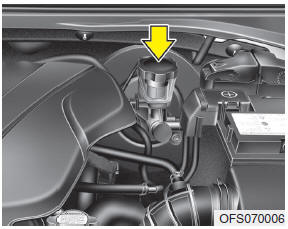 Hyundai Veloster: Brake/clutch fluid
Hyundai Veloster 2011-2017 Owner's Manual / Maintenance / Brake/clutch fluid
Hyundai Veloster: Brake/clutch fluid
Hyundai Veloster 2011-2017 Owner's Manual / Maintenance / Brake/clutch fluid
Checking the brake/clutch fluid level

Check the fluid level in the reservoir periodically. The fluid level should be between MAX and MIN marks on the side of the reservoir.
Before removing the reservoir cap and adding brake/clutch fluid, clean the area around the reservoir cap thoroughly to prevent brake/clutch fluid contamination. If the level is low, add fluid to the MAX level. The level will fall with accumulated mileage. This is a normal condition associated with the wear of the brake linings. If the fluid level is excessively low, have the brake system or clutch (if equipped) checked by an authorized HYUNDAI dealer.
Use only the specified brake fluid. (Refer to “Recommended lubricants or capacities” in section 8.)
Never mix different types of fluid.
WARNING - Loss of brake/ clutch fluid
In the event the brake system requires frequent additions of fluid, the vehicle should be inspected by an authorized HYUNDAI dealer.
WARNING - Brake/clutch fluid
When changing and adding brake fluid, handle it carefully. Do not let it come in contact with your eyes. If brake fluid should come in contact with your eyes, immediately flush them with a large quantity of fresh tap water. Have your eyes examined by a doctor as soon as possible.
CAUTION
Do not allow brake fluid to contact the vehicle's body paint, as paint damage will result. Brake fluid, which has been exposed to open air for an extended time should never be used as its quality cannot be guaranteed. It should be disposed of properly. Don't put in the wrong kind of fluid. A few drops of mineral- based oil, such as engine oil, in your brake system can damage brake system parts.
 Changing the coolant
Changing the coolant
Have coolant changed by an authorized HYUNDAI dealer according to the Maintenance
Schedule at the beginning of this section.
CAUTION
Put a thick cloth or fabric around the radiator cap before refi ...
 Washer fluid
Washer fluid
Checking the washer fluid level
The reservoir is translucent so that you can check the level with a quick visual
inspection.
Check the fluid level in the washer fluid reservoir and add fluid if ...
See also:
AVN Head Unit. Repair procedures
Removal
AVN Head Unit
•
Take care not to scratch the center fascia panel and related
par ...
Shift Lever > Components and Components Location
Components
1. Shift lever knob
2. Shift lever assembly
3. Control cable assembly
...
Rear Washer Motor. Repair procedures
Inspection
1.
With the washer motor connected to the reservoir tank, fill the
reservoir tank with water.
...
Categories
- Hyundai Veloster Manuals Home
- Hyundai Veloster 2010-2017 Owner's Manual
- Hyundai Veloster 2010-2017 Service Manual
